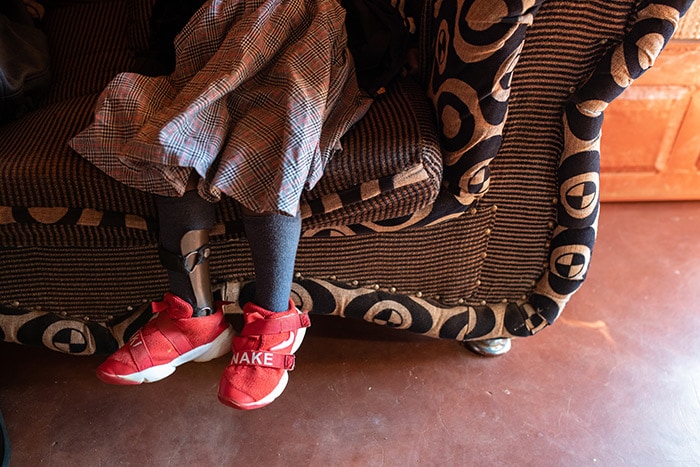Why CDC is Working to End Polio Globally
Updated September 27, 2023

A three-year old child in Malawi experienced paralysis in her leg in 2021, as a result of the first case of wild polio reported in Southeastern Africa since 2016. Credit: ©UNICEF/U.S. CDC/UN0641187/Paul
CDC has a long history of fighting polio – beginning in the 1950s. Today, CDC is focused on ending polio globally, including addressing polio in the U.S. recently.
Polio Can Lead to Paralysis and Death
The world has come a long way in the fight against polio. In 1988, there were 350,000 cases of wild polio across 125 countries – with more than 1,000 children per day becoming paralyzed. In 2022, there were only 30 cases in three countries:
- Afghanistan and Pakistan, where wild poliovirus circulation is still endemic (consistently present)
- Mozambique, which had an outbreak following importation of wild poliovirus from Pakistan
Efforts to eradicate polio over the last few decades have prevented more than 20 million cases of paralysis. However, if wild poliovirus transmission continues in Pakistan and Afghanistan, children worldwide remain at risk of paralysis.
Ending Polio is Cost Effective

In 2022, a health worker in India provided children with multiple interventions – including polio vaccines and Vitamin A – at once. Credit: ©UNICEF/U.S. CDC/UN0735400/Khemka
To end global polio, partners and national governments are working together to vaccinate more than 400 million children a year. With polio vaccines costing as little as 11 cents (in US currency) a dose, this relatively small investment can save countless children from paralysis and death.
The global goal is to eradicate polio – stopping the virus entirely. Analysis shows that eradication, as compared to dealing with polio spread indefinitely, will save more than $33 billion in health-related costs by the year 2100.
Furthermore, the same healthcare workers who administer polio vaccines have also delivered billions of doses of vitamin A – which decreases the risk of disease and death among children without access to complete nutrition – since 1988. This combined campaign strategy provides multiple health benefits from a single campaign.
Polio Transmission Anywhere Puts Children at Risk Everywhere
The best way to keep people safe from polio is through vaccination.
Polio was once one of the most feared diseases in the United States. Before polio vaccines became available in the 1950s, polio paralyzed more than 15,000 people each year in the United States. Thanks to widespread polio vaccination in the United States, wild polio has been eliminated – with no cases occurring in the country since 1979.
However, it takes only one traveler with polio to bring the disease into a country. Communities with low polio vaccination rates are at risk of polio spreading from infected travelers, or having outbreaks from poliovirus variants that can emerge over time.
For instance, wild poliovirus had not been detected in southeastern Africa since the 1990s, and the continent of Africa was certified free of wild polio in 2020. However, in 2021 and 2022, wild poliovirus – imported from Pakistan –was reported circulating first in Malawi and later in Mozambique. The outbreak caused paralysis in nine children.
Poliovirus Variants Present an Ongoing Challenge
More information from the Global Polio Eradication Initiative (GPEI):
In addition to stopping ongoing wild poliovirus in two remaining countries – Afghanistan and Pakistan – CDC and partners are faced with the challenge of poliovirus variants (also known as “vaccine-derived poliovirus”).
Variants of poliovirus, while rare, can emerge and spread in communities where too few people are vaccinated against polio.
How poliovirus variants emerge:
- Members of a community receive oral polio vaccines, which contain a weakened form of poliovirus.
- The weakened virus spreads in the community, providing immunity to some children who did not receive the vaccine.
- If that spread (which is initially beneficial) happens for too long in communities with low vaccination rates, it can become harmful. Over time, the weakened virus begins to mutate as it spreads from person to person.
- Eventually, the virus may mutate into a variant that can cause paralysis in people who are not immune to polio.
CDC is Helping to End Polio as Part of the Global Polio Eradication Initiative
Finding and getting rid of the virus everywhere in the world is challenging because it remains in areas that often need significant resources to address the issue.
Backed by strong investments and political commitment, the Global Polio Eradication Initiative (GPEI) has helped bring us to the brink of a polio-free world. Persistent challenges, exacerbated by the COVID-19 pandemic, have prompted the program to refocus its approach to achieving eradication.
GPEI’s Polio Eradication Strategy 2022-2026 has two goals:
- Permanently interrupt all wild poliovirus transmission
- Stop the transmission of poliovirus variants and prevent outbreaks
Once these goals are reached, GPEI is committed to ensuring a smooth transition to country health programs so the world remains polio-free, disseminating knowledge generated from eradication, and supporting other health priorities that benefit from the eradication effort, such as global Vitamin A supplementation.
- CDC
- Global Polio Eradication Initiative (GPEI)